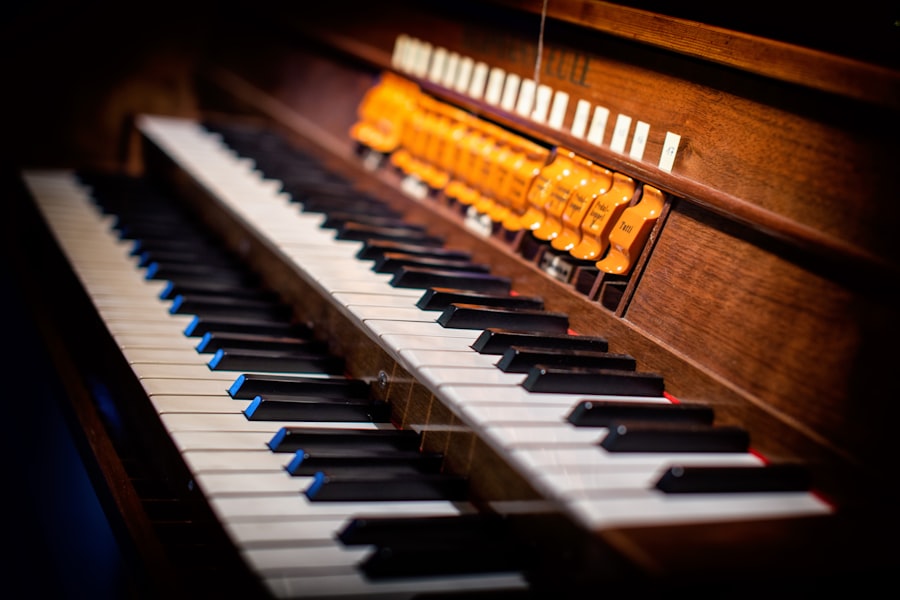Taoism, an ancient Chinese philosophy and spiritual tradition, emphasizes living in harmony with the Tao, or the fundamental nature of the universe. This philosophy is deeply rooted in the understanding of balance, simplicity, and the interconnectedness of all things. Music, in this context, serves as a profound expression of these principles.
It is not merely an art form but a means of connecting with the Tao, allowing individuals to experience the flow of life and the rhythms of nature. The melodies and harmonies found in Taoist music often reflect the natural world, embodying the cycles of change and the essence of existence. In Taoist thought, music is seen as a bridge between the material and spiritual realms.
It transcends language and cultural barriers, resonating with the universal truths that underpin existence. The use of specific scales, instruments, and improvisational techniques in Taoist music is intentional, aiming to evoke a sense of tranquility and unity with the cosmos. For instance, traditional instruments like the guqin and dizi are not just tools for creating sound; they are extensions of the musician’s spirit, channeling the energy of the universe into audible form.
This connection between music and the Tao reflects a deep understanding of how sound can influence emotions, thoughts, and even physical states.
Key Takeaways
- Taoism emphasizes the harmony and balance of nature, which is reflected in the philosophy of music as a means of connecting with the natural world.
- Music is seen as a tool for balancing the yin and yang energies within the body and mind, promoting a sense of equilibrium and well-being.
- In Taoist tradition, music is believed to have the power to heal and restore harmony to the body, mind, and spirit, promoting overall wellness.
- The five elements of wood, fire, earth, metal, and water are believed to influence musical composition, with each element evoking different emotions and energies.
- Mindfulness and meditation are integral to the practice of music making in Taoism, allowing musicians to cultivate a deep sense of presence and connection to the music.
The Role of Music in Balancing Yin and Yang Energies
The Interplay of Yin and Yang in Music
Music plays a crucial role in balancing these energies, creating an auditory landscape that can either amplify or soothe emotional states. The characteristics of a piece of music can evoke either Yin or Yang qualities, influencing the listener’s emotional response. For example, soft, flowing melodies may promote relaxation and introspection, while lively rhythms with sharp accents can stimulate energy and encourage movement.
Practical Applications of Yin and Yang in Music
The interplay between Yin and Yang in music has practical applications in various aspects of life. Musicians often consciously choose elements that align with these energies to achieve desired emotional effects. In a therapeutic setting, calming sounds may be used to help patients release stress and embrace tranquility, while upbeat tempos may be employed to invigorate and inspire action.
Maintaining Harmony through Music
The dynamic balance between Yin and Yang is essential for maintaining harmony within oneself and with the surrounding environment. Music can serve as a powerful tool for achieving personal and communal equilibrium, illustrating the importance of considering the interplay of Yin and Yang in music.
The Healing Power of Music in Taoist Tradition

The healing power of music is a cornerstone of Taoist practice, where sound is believed to have profound effects on both the body and spirit. In traditional Chinese medicine, it is understood that different frequencies can resonate with specific organs and meridians within the body. This resonance can facilitate healing by restoring balance to one’s internal energies.
For example, certain musical tones may be used to stimulate the liver or calm the heart, promoting overall well-being. Taoist healing practices often incorporate music into rituals and therapies. Sound baths, where participants immerse themselves in harmonious vibrations produced by instruments like singing bowls or gongs, exemplify this approach.
These sessions aim to align the body’s energy centers (or chakras) through sound waves that penetrate deeply into one’s being. The experience can lead to profound states of relaxation and emotional release, allowing individuals to connect with their inner selves and promote healing on multiple levels. This integration of music into healing practices underscores its significance within Taoist philosophy as a means to achieve holistic health.
Understanding the Five Elements and their Influence on Musical Composition
The Five Elements—Wood, Fire, Earth, Metal, and Water—are fundamental concepts in Taoist philosophy that describe various aspects of nature and human experience. Each element corresponds to specific emotions, seasons, colors, and even musical notes. For instance, Wood is associated with spring and growth; its musical representation might include bright melodies that evoke feelings of renewal.
Fire corresponds to summer and passion; compositions inspired by this element may feature dynamic rhythms that ignite energy. Musical compositions influenced by these elements often aim to evoke particular emotional responses or create specific atmospheres. A piece inspired by Earth might utilize steady rhythms and rich harmonies to instill a sense of grounding and stability.
In contrast, Water-inspired music may flow gently with undulating melodies that encourage introspection and calmness. Composers who understand these connections can craft pieces that resonate deeply with listeners on both emotional and spiritual levels, creating an immersive experience that reflects the natural world.
The Practice of Mindfulness and Meditation in Music Making
Mindfulness and meditation are integral components of Taoist philosophy, emphasizing presence and awareness in every moment. When applied to music making, these practices transform the act of creating sound into a meditative experience. Musicians who engage in mindfulness while playing or composing often find themselves more attuned to their inner thoughts and feelings as well as to the energies around them.
This heightened awareness allows for a deeper connection with the music itself, fostering creativity that flows naturally from within. Incorporating meditation into music making can take various forms. Some musicians may begin their practice with deep breathing exercises or visualization techniques to center themselves before playing.
Others might focus on the sensations produced by their instruments—the vibrations felt through their fingertips or the resonance within their bodies—as they create sound. This approach not only enhances musical expression but also cultivates a sense of peace and fulfillment that aligns with Taoist ideals. By embracing mindfulness in music making, artists can transcend technical skill alone and tap into a more profound source of inspiration.
Harmonizing Sound and Spirit through Musical Improvisation

The Principle of Flow
Improvisation is a vital aspect of musical expression within Taoist traditions, allowing musicians to connect spontaneously with their inner selves and the surrounding environment. This practice embodies the principle of flow—an essential concept in Taoism—where one surrenders to the moment and allows creativity to unfold naturally.
A Dialogue of Sound
The act of improvisation can be seen as a dialogue between musicians or between a musician and their audience. As sounds emerge organically from this interaction, they create a shared space where individuals can experience unity and connection. This process not only enhances individual creativity but also fosters communal bonds among participants.
A Reflection of Life
In many ways, improvisation serves as a reflection of life itself—unpredictable yet beautiful—encouraging musicians to embrace spontaneity while remaining grounded in their connection to the Tao.
The Importance of Silence and Space in Taoist Music
Silence holds significant value in Taoist music; it is not merely an absence of sound but an essential component that enhances musical expression. In Taoist philosophy, silence represents potentiality—the space from which all creation emerges. By incorporating pauses and moments of stillness into musical compositions or performances, musicians can create tension that heightens emotional impact when sound resumes.
This interplay between sound and silence mirrors the natural rhythms found in nature, where periods of quiet are often followed by bursts of activity. Moreover, silence allows listeners to engage more deeply with the music itself. It provides an opportunity for reflection and introspection, inviting individuals to explore their thoughts and feelings without distraction.
In this way, silence becomes a powerful tool for enhancing mindfulness within musical experiences. Musicians who understand the importance of space can craft performances that resonate on multiple levels—inviting audiences not only to hear but also to feel and contemplate.
Embracing the Flow of Nature in Musical Expression
Taoism teaches that humans are an integral part of nature; thus, embracing its flow is essential for authentic musical expression. Musicians who attune themselves to natural rhythms—such as the changing seasons or the ebb and flow of tides—can create works that resonate deeply with both themselves and their audiences. This connection fosters a sense of unity with the world around them, allowing for a more profound exploration of themes related to life’s cycles.
In practice, this might involve drawing inspiration from natural sounds—like birdsong or wind rustling through leaves—and incorporating those elements into compositions or improvisations. Musicians may also seek to embody nature’s spontaneity by allowing their creative processes to unfold organically rather than adhering strictly to predetermined structures or forms. By embracing this fluidity in musical expression, artists can create works that reflect not only their personal experiences but also the broader tapestry of existence itself—a true embodiment of Taoist philosophy in action.
FAQs
What is the Tao of Music?
The Tao of Music refers to the concept of harmonizing sound and spirit, drawing from the principles of Taoism to create a deeper connection between music and the human experience.
How does the Tao of Music relate to Taoism?
Taoism emphasizes the natural flow of life and the balance of yin and yang. The Tao of Music applies these principles to the creation and appreciation of music, seeking to achieve harmony and balance in both the sound and the listener’s spirit.
What are the key principles of the Tao of Music?
Key principles of the Tao of Music include embracing simplicity, finding balance and harmony, and connecting with the natural rhythms of life. It also involves cultivating a sense of mindfulness and presence in the music-making process.
How can one apply the Tao of Music in their musical practice?
Practicing the Tao of Music involves approaching music with a sense of reverence and mindfulness, seeking to create and experience music in a way that aligns with the natural flow of life. This can involve techniques such as meditation, improvisation, and a focus on the emotional and spiritual aspects of music.
What are the benefits of embracing the Tao of Music?
Embracing the Tao of Music can lead to a deeper connection with music, a greater sense of peace and harmony, and a more profound emotional and spiritual experience. It can also enhance creativity and musical expression.









Add Comment